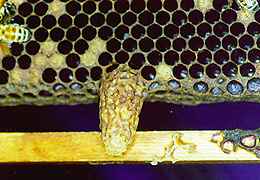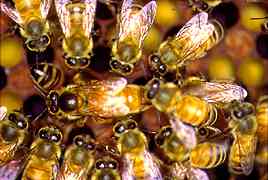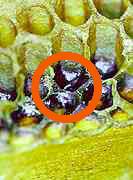 |
Do Only Queen Bees Lay Eggs? |
After copulating during the mating flight, the queen bee is given royal jelly by worker bees in the beehive. After that, the belly of the queen bee enlarges, and 2 days later, at the earliest, she starts laying eggs. She continues laying every day for the next 2 to 4 years except during the hottest days of summer and the coldest days of winter. The queen bee is always surrounded by a lot of worker bees, but during this time, the queen bee secretes a special pheromone to suppress the ability of the worker bees to lay eggs. This is the reason why worker bees cannot lay eggs even though worker bees are female. Under some circumstances, if there is no queen bee, the worker bees start laying eggs, but only male bees are born because the eggs are unfertilized.
 |
How a New Queen Bee Is Decided. |
When spring comes, worker bees make a special room called a queen cell, in which a queen bee is raised. Originally, all of the eggs are fertilized because the queen bee and the worker bees are female. They emerge 3 days later, and they are the same larvae. Only a larva born in the queen cell is given royal jelly by worker bees and becomes a queen bee. However, it is not so easy to become a queen bee. About 10 queen cells are made, and the same number of queen bee candidates are born. After a fight to the death in which there is only one winner, a new queen bee is selected. At that time, the old queen bee leaves the beehive and moves to a new one.

 |
Worker Bees Grow Up Slowly. |
The queen bee measures the size of nursing rooms with her front legs, and lays the eggs of drones in the larger rooms and the eggs of worker bees in the smaller rooms. When laying the eggs of worker bees, which are female, the queen bee lets out sperm which was stored in her body to fertilize them right before laying the eggs. The larvae of worker bees are given almost the same meal of royal jelly for a while, then on the 3rd day or so, larvae start growing bigger and pollen and honey are added to their diet. Due to differences in diet, the larval stage is 5.5 days for the queen bee and 6 days for worker bees. The pupal stage is 7.5 days for the queen bee and 15 days for worker bees. When worker bees reach maturity they begin to clean and raise children.

 |
Are Drones Left Alone? |
The queen bee and worker bees are born from fertilized eggs. Drones are born from unfertilized eggs. Meals are the same as those for worker bees, but drones have bigger bodies and more food is given to them than to the worker bees. As the days pass, pollen is mixed in with the food. Its mixing rate is bigger than that for worker bees, which means worker bees receive better food. The days to emergence are the same as those for worker bees, but the periods of the larval and pupal stages are a little longer than those for worker bees.
|

![]()




